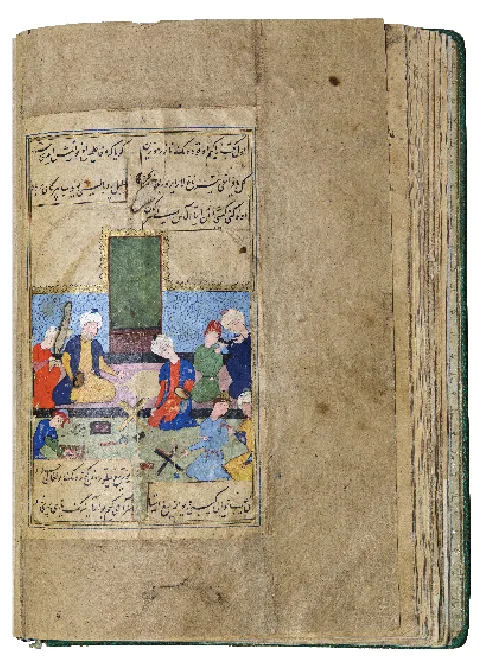
Among the illustrated manuscripts from the first of group are three interesting works by Nawai – Inventory Nos. 5802, 7463 and 2197 (dated 954 AH/1574 – 1575) and “Yusuf wa Zulaikha” by Jami, Inventory No. 9597.
Stylistically the miniatures of the first two manuscripts belong to a group, sometimes related to the Tabriz or the Shiraz schools of the second quarter of the 16th century. Taking into consideration that Nawai wrote in the Turkic language, they were probably produced in the same region of Sefevid Iran where this language was spoken, most likely in Tabriz, Azerbaijan, the outstanding centre of miniature art – Tabriz patronized by Shah Tahmasib. However we do not exclude here the work of the miniaturists from the Shiraz school.
The miniatures in the manuscripts of Inventory Nos. 5802 and 7463 were created by expert miniaturists. The subjects are traditional: hunting, polo, archery with an arrow flying from a bow at full tilt into a gilt apple on a stick and garden feasts. The drawing is fine, the colors are fresh, and the gestures of people and horses are absolutely natural. Their style is analogous with the miniatures of the Tabriz and Shiraz schools of the 16th century, but not with the best examples. All there miniatures were produced according to schemes, which were transferred by the artists from one manuscript to another. For example, a scene of an archery competition in the manuscript by Nawai Inventory No. 5802 is very similar to the composition of the miniature from the collection of Keire, and a hunting scene in both manuscripts can be compared with a similar scene in “Zafar-nama” dated 1523 in the British Museum. Similar compositions can be seen in the copy Inventory No. 2197. The miniatures in the manuscript Inventory No. 9597 were made by a mediocre artist. The compositions have few figures and dry interpretation of architectural ornamentation. This is one of those craft works, which coexisted alongside creations of the first-rate artists within the Sefevid school of the miniature. It would be unfounded to relate the miniatures from the manuscript Inventory No. 7463 to Herat, since by their composition, characters and general iconography they are typical of the first group.
The details of dress and headdresses are identical with those from the copies of “Yusuf wa Zulaikha” by Jami 940 AH/1533 – 34 and “Diwan” by Amir Khusraw Dehlevi 943 AH/1537 (both copies in the collection of the National Library in Paris), in “Guy-i chawgan” 931 AH/1524 – 25 and “Diwan” by Hafiz 939H/1532. Presuming they are close in date to the miniatures “Garaiyb-al-sigar”, they can be dated to the 1620s or 1630s. The miniatures are of good quality but lack of the professional finesse, demonstrated by highly-skilled artists.
You can learn more about this topic in the book-album “The Collection of the Al-Biruni Institute of Oriental studies, the Academy of Sciences of the Republic of Uzbekistan” (part five, “Miniature and Calligraphy”) (Volume XXV) from the series "The Cultural Legacy of Uzbekistan".
The main sponsor of the project is the oilfield services company Eriell-Group.

